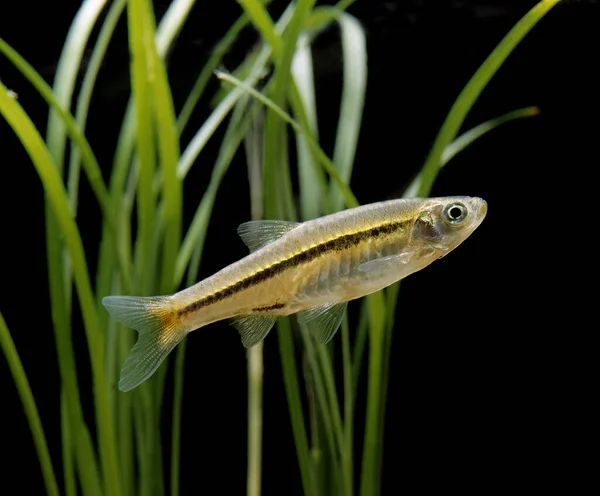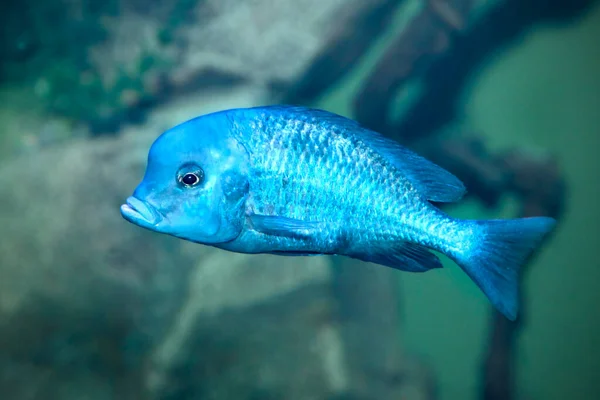Incredibly, many fishes with fish names start with M. Some are strictly ornamental fish, others are subtropical reef-dwelling fish, and some are either, depending on the type of species.
But researching fish names is easier when you know their scientific names and common names.
Check out this article for fish that start with M.
Our Top 5 Fish Names That Start With M
Magnificent Rasbora (Rasbora borapetensis)

The Magnificent rasbora is a very peaceful fish native to the freshwater rivers in Asia. You can find them in the freshwaters of South East Asia and South East China.
Rasbora is a genus in the Cyprinidae family. As a common English name in the aquarium hobby, it covers many species, including the Boraras, Megarasbora, Microrasbora, Rasboroides, and Rasbosoma species.
The Magnificient rasbora is a small fish with a maximum length of no more than 6 inches.
Its body is fairly yellow with a black line that runs along the middle from the back of the gills to the caudal fin.
It is a very hardy fish. But an unfavorable water condition will result in a paler red area on the tail. It is a schooling fish, so keeping about 8-10 of the same species in the community tank would be best.
Loaches, Tetras, and catfish are great choices if you want them in a community tank.
Marbled Hatchetfish (Carnegiella strigata)

The Marbled Hatchetfish is native to South America. Their ideal habitat is black acidic water wit to keep h a lot of decaying organic matter.
Although the Marbled Hatchetfish is a small fish, you want to keep a lid on your aquarium. This is important because they have a penchant for jumping out of the tank when stunned.
It has a magnificent appearance with a gold line that runs from its eyes to its caudal fin.
Its underside looks like marble, so it is called the Marbled Hatchetfish. Another distinguishing feature of this fish is its hatchet shape. It has a flat back and widespread pectoral fins.
Marbled Hatchetfishes are usually wild captured.
You want to limit the chances of spreading any bacteria by putting the fish in a quarantine tank before introducing it to your aquarium. Quarantine the fish for 14 days to keep your community tank safe.
Malawi Golden Cichlid (Melanochromis auratus)

This dazzling tropical fish is a must-mention in our top 5 list. It is part of the Cichlidae family. Golden Mbuna is another name for this fascinating fish.
You can find them in the Malawi lake, especially along the South of Jalo Reefs, to Crocodile Rocks.
It is a small fish, and it is trendy in the hobby. They grow up to a maximum length of 4.3 inches.
They display sexual dimorphism with body colors. Females and young Malawi golden cichlids are primarily yellow. The males have dark brown or black.
They also have a brighter shade of blue or back on the upper half of their body.
Interestingly, females can also change their sex to become males if there are no males in the tank.
They will appear to have a dark deep body color to signal their dominance.
In pet stores, the male in the tank would have black color for dominance while the rest will be yellow.
After the dominant male is purchased, another dominant male will emerge in black color.
Molly (Poecilia sp.)

Molly comprises many fish species. The Molly fish species are great beginner choices for amateurs in the hobby.
Fish species known as Molly include the Sailfin Molly (Poecilia latipinna), Common Molly (Poecilia sphenops), Elegant Molly (Poecilia elegans), and Amazon Molly (Poecilia formosa), etc.
Their natural habitats include shallow water surfaces, small streams, and planted brackish waters. It is popularly believed that they are freshwater species that usually spend a short time in brackish waters.
These fish species have been spotted flourishing in the coastal sea waters, brackish streams, reef areas, estuaries, and freshwater streams.
Molly species are closely related as they are from the same genus in the Poeciliidae family. You can notice the difference between the specific species in their appearance.
The Sailfin Molly has a dorsal fin that looks like the sail of a boat, while Common Molly has a shorter dorsal fin.
The Black Lyretail Molly is dark with black scales and white highlights on its dorsal and anal fins. Many other Molly species have their distinguishing features.
Malawi Blue Dolphin (Cyrtocara moorii)

This large and striking Malawian Cichlid is endemic to Lake Malawi. This fish was previously identified with the scientific name Haplochromis moorii.
It grows up to an impressive size of 10 inches in length. They sometimes grow larger than 10 inches in the aquarium if well taken care of.
Over time, it grows a large bump on its head and an elongated snout. It also grows a large mouth and an extended tight body with age.
The dorsal fins of these giant Malawian Cichlids are usually long and span from the back of their heads to their tails.
Their pelvic fins stand out close to a small budge under their big heads. It is not uncommon to find them with a long anal fin that almost touches their tails.
Unlike other blue cichlids with bright blue line fins, Malawi Blue Dolphins are usually plain blue.
They may appear to have bright blue line fins, but their colors are generally not as bright as the Electric Ram Cichlid.
List of Fish Beginning with M
Apart from our top picks above, there are other great fishes with fish names that start with M. Check out the lists below.
Freshwater Fish Beginning with M
- Macculloch’s Rainbowfish (Melanotaenia maccullochi)
- Macmaster’s Dwarf Cichlid (Apistogramma macmasteri)
- Madagascar Rainbowfish (Bedotia geayi)
- Madeirae Swamp Eel (Synbranchus madeirae)
- Madtom (Noturus placidus)
- Magnificient Rasbora (Rasbora borapetensis)
- Mahseer (Tor tambroides)
- Mail-Cheeked Fish (Pterois antennata)
- Malarmo Catfish (Duopalatinus malarmo)
- Malawi Blue Dolphin (Cyrtocara moorii)
- Malawi Golden Cichlid (Melanochromis auratus)
- Malawi Eye-Biter (Dimidiochromis compressiceps)
- Malay Combtail (Belontia hasselti)
- Manchurian Loach (Leptobotia mantschurica)
- Mandarinfish (Siniperca scherzeri)
- Mangrove Red Snapper (Lutjanus argentimaculatus)
- Many Banded Shell-Dweller (Neolamprologus multifasciatus)
- Many-Spotted Cory (Corydoras polystictus)
- Marakeli Cichlid (Paratilapia polleni “Madagascar”)
- Marbled Bichir (Polypterus palmas)
- Marbled Hatchetfish (Carnegiella strigata)
- Marbled Headstander (Abramites hypselonotus)
- Marbled Lamprologus (Lepidiolamprologus attenuatus)
- Marbled Livingston’s Hap (Nimbochromis livingstonii)
- Marbled Otocinclus (Otocinclus paulinus)
- Marbled Sleeper Goby (Oxyeleotris marmorata)
- Marbled Swamp Eel (Synbranchus marmoratus)
- Marigold Swordtail (Xiphophorus helleri)
- Marigold Wag Swordtail (Xiphophorus helleri)
- Marlier’s Julie (Julidochromis marlieri)
- Marylin’s Pencilfish (Nannostomus marylinae)
- Masked Julie (Julidochromis transcriptus)
- Maylandia Aurora (Pseudotropheus aurora)
- Medaka (Oryzias latipes)
- Meridionalis Gray Bichir (Polypterus senegalus meridionalis)
- Mexican Golden Trout (Oncorhynchus chrysogaster)
- Mexican Sailfin Molly (Poecilia velifera)
- Mexican Swordtail (Xiphophorus montizumae)
- Mexican Tetra (Astyanax fasciatus mexicanus)
- Mickey Mouse Platy (Xiphophorus maculatus)
- Midas Cichlid (Amphilophus citrinellus)
- Millions Fish (Poecilia reticulata)
- Minnow (Pimephales promelas)
- Modest Loach (Botia modesta)
- Modoc Sucker (Catostomus microps)
- Mola Mola (Mola mola)
- Molly “Black” (Poecilia sphenops)
- Mono (Monodactylus argenteus
- Montezuma helleri (Xiphophorus montizumae
- Mooneye (Hiodon tergisus)
- Moonfish “Red Wag” (Xiphophorus maculatus)
- Moonfish “Vtiatus Sunset” (Xiphophorus maculatus)
- Moonlight Gourami (Trichogaster microlepis)
- Moore’s Lamprologus (Variabilichromis moorii)
- Mosaic Gourami (Trichogaster leeri)
- Mosquitofish (Gambusia affinis)
- Moss Barb (Capoeta tetrazona)
- Motoro Stingray (Potamotrygon motoro)
- Mottled Ctenopoma (Ctenopoma oxrynchum)
- Mottled Stingray (Potamotrygon hystrix)
- Mozambique Tilapia (Oreochromis mossambicus)
- Mrigal (Cirrhinus cirrhosus)
- Mud Catfish (Mud cat)
- Mud Minnow (Galaxiella munda)
- Mudfish (Neochanna apoda)
- Mudminnow (Umbra pygmaea)
- Murray Cod (Maccullochella peelii)
- Muskellunge (Esox masquinongy)
Saltwater Fish Beginning with M
- Mackerel (Rastrelliger brachysoma)
- Mackerel Shark (Carcharodon carcharias)
- Mahi-Mahi (Coryphaena hippurus)
- Mako Shark (Isurus oxyrinchus)
- Man-of-War Fish (Nomeus gronovii)
- Mandarinfish (Synchiropus splendidus)
- Manta Ray (Manta alfredi)
- Marblefish (Aplodactylus arctidens)
- Marine Hatchetfish (Argyropelecus hemigymnus)
- Marlin (Makaira nigricans)
- Masu Salmon (Oncorhynchus masou)
- Medusafish (Centrolophus niger)
- Megamouth Shark (Megachasma pelagios)
- Menhaden (Brevoortia patronus)
- Merluccid Hake (Merluccius bilinearis)
- Midshipman Fish (Porichthys notatus)
- Milkfish (Chanos chanos)
- Minnow of the Deep (Cyclothone microdon)
- Mojarra (Gerres equulus)
- Monkeyface Prickleback (Cebidichthys violaceus)
- Monkfish (Lophius piscatorius)
- Moorish Idol (Zanclus cornutus)
- Mora (Mora moro)
- Moray Eel (Anarchias seychellensis)
- Morid Cod (Laemonema barbatulum)
- Morwong (Cheilodactylus spectabilis)
- Moses Sole (Pardachirus marmoratus)
- Mudskipper (Periophthalmus novemraditus)
- Mudsucker (Gillichthys detrusus)
- Mullet (Mugil cephalus)
- Mummichog (Fundulus heteroclitus)
- Mustache Triggerfish (Balistoides viridescens)
- Mustard Eel (Dysomma anguillare)

